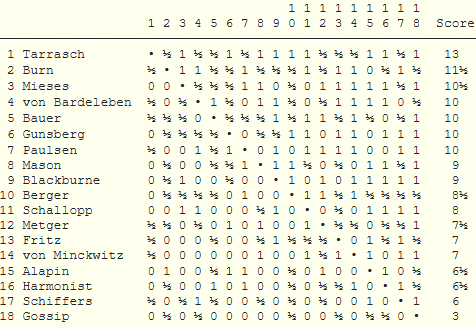Bullion in Breslau

Old Town Hall in Wrocław
One of the most celebrated legends of chess lore concerns a game won by the American champion and grandmaster Frank Marshall in 1912 at the tournament of Breslau, then in the German Empire (now Wroclaw in Poland). Marshall sacrificed his Queen in sparkling fashion and was allegedly rewarded with a shower of gold coins by the astonished and admiring throng of spectators.

Frank James Marshall
A surviving photo of the key move about to be executed does indeed show a group of fans crowding round the board, so the story may have an air of plausibility.
Here is that crucial moment, with Black about to unleash the fatal blow.

Left: Frank Marshall (to play); Right: Stepan Levitsky (in for a shock)
Watching the game, wealthy Breslau chess fans, about to hurl their golden Reichsmarks onto the board.
Black to play

Black now plays the astonishing: 23… Qg3!!!
The Queen can be taken in three different ways. Yet White immediately resigns. Why?
The main threat is an immediate mate on h2. If, to prevent this, White plays 24. hxg3, then 24… Ne2 is checkmate. Alternatively, should White instead capture, 24. fxg3, then 24… Ne2+ 25. Kh1 Rxf1 is checkmate. Should White try and provide an escape square for his king to meet …Qxh2+ with 24. f4, then we have again, 24… Ne2+, with 25. Kh1 Qxh2 checkmate. Finally, if White overprotects h2 with 24. Qe5, then 24… Ne2+ 25. Kh1 Rxh2 checkmate.
A more covoluted defence with 24. Qxg7+, ultimately fails to, 24… Kxg7 25. Rg5+ Qxg5 26. Rb1 b6 27. Re1 Qf4 28. gxh3 Qxf2+ 29. Kh1 Nf3 30. Rxe6 Qxh2 checkmate. Of course, White can vary a few of these moves, but the motif remains and checkmate is inescapable after whatever White chooses to deviate with.
The good news for White is that there is one solitary line where Black does not immediately attain a checkmate. 24. Qxg3! But after 24… Ne2+ 25. Kh1 Nxg3+ 26. Kg1 (but not 26. fxg3?? Rxf1 checkmate) 26… Ne2+ 27. Kh1 Rc3 with the following:-
- a) 28. Re5 Rxc2 29. g3 Nd4 30. Re4 Rd2 31. a4 h5 32. Kg2 b6 33. Re3 Kh7; or
- b) 28. Ra5 a6 29. g3 Nd4 30. Kg2 Rxc2 31. Ra3 e5 32. Re3 Nc6 33. a3 b5; or
- c) 28. Rb5 b6 29. Rb2 Rfc8 30. g3 Rxc2 31. Rb4 Nc3 32. Kg2 Nd5 33. Re4 Kf7;
all of which leave Black with a generous and easily winning material advantage.
Breslau seems to have been a hive of intellectual ferment and there were several elite chess competitions hosted in that university city, whose academic credentials date back to the early 16th century. Breslau’s chess reputation is based on three outstanding events from 1889, 1912 and 1925. The depth of talent can be clearly ascertained from the respective following cross-tables for those events.
6th DSB Congress, Breslau (1889)

At this event Emanuel Lasker made his debut and earned his Master title in the second section. The next great manifestation took place after a further 23 years.
18th DSB Congress, Breslau (1912)

Although the mighty Akiba Rubinstein never attained the goal of challenging for the world title, he was then at his peak. Breslau 1912 was distinguished by the presence of three other aspirants to Lasker’s hegemony, namely Schlechter, Tarrasch and the ingenious Marshall, originator of the …Qg3 coup.
24th DSB Congress, Breslau (1925)

Great Breslau events went out with a bang in 1925 with a colossal victory by Bogoljubow, one of a series which certainly justified his selection as challenger to world champion Alekhine in 1929.

Dr. Siegbert Tarrasch, German physician and chess grandmaster
Breslau/Wroclaw University can boast no fewer than nine Nobel prize winners. In chess, it has connections with the great Johannes Zukertort, while Daniel Harrwitz, Siegbert Tarrasch and Adolph Anderssen were all born there. A stupendous roll of chess honour indeed.
Marshall’s exploit, the Breslau Brilliancy, was later emulated by Rossolimo, Alekhine and Bronstein.

Rossolimo-Reissmann (1967)
White has just unleashed the killer blow, Qg6!!, after which checkmate is inevitable eg 1… fxg6 2. Nxg6+ hxg6 3. Rh3, finito!

Alekhine-Supico (1941)
Not to be outdone, the towering genius Alekhine also pulled off his own interpretation of the Breslau Brilliancy. Alekhine has struck with 1. Qg6!! and after 1… fxg6 2. Nxg6+ hxg6 3. Rh3+, the game is up

Bronstein- Geller (1961)
The cunning Soviet world title challenger David Bronstein is our final member of the Breslau club. White’s bombshell 1. Qg6!! leads to checkmate after, 1… fxg6 2. Rxg7+ and whichever reply Black chooses, 3. Nxg6 checkmate follows.
On Tuesday May 13, there will be an evening reception and dinner at L’Escargot to celebrate the paperback launch of Chess through the Looking Glass. For further details please contact Ima Von Wenden at secretary@snailclub.co.uk
Ray’s 206th book, “
Chess in the Year of the King
”, written in collaboration with Adam Black, and his 207th, “
Napoleon and Goethe: The Touchstone of Genius
” (which discusses their relationship with chess) can be ordered from both Amazon and Blackwells. His 208th, the world record for chess books, written jointly with chess playing artist Barry Martin,
Chess through the Looking Glass
,
is now available from Amazon.
A Message from TheArticle
We are the only publication that’s committed to covering every angle. We have an important contribution to make, one that’s needed now more than ever, and we need your help to continue publishing throughout these hard economic times. So please, make a donation.





